KIA Niro: CVVT & Camshaft Repair procedures
Removal
Warning
- Use fender covers to avoid damaging painted surfaces.
- To avoid damaging the cylinder head, wait until the engine coolant temperature drops below normal temperature (20ºC (68ºF)) before removing it.
- When handling a metal gasket, take care not to fold the gasket or damage the contact surface of the gasket.
- To avoid damage, unplug the wiring connectors carefully while holding the connector portion.
- Turn the crankshaft pulley so that the No. 1 piston is at TDC (Top dead center).
Warning
Mark all wiring and hoses to avoid misconnection.
Warning
- Be sure to read and follow the "General Safety Information and Caution" before doing any work related with the high voltage system. Failure to follow the safety instructions may result in serious electrical injuries.
- Be sure to shut off the high voltage circuit according to the "High Voltage Shut-off Procedures" before doing any work related with the high voltage system to avoid serious electrical injuries.
- Shut off the High Voltage circuit.
(Refer to General Information - "High Voltage Shutoff Procedure")
- Remove the cylinder head cover.
(Refer to Cylinder Head Assembly - "Cylinder Head Cover")
- Set No.1 cylinder to TDC (Top dead center) on compression stroke.
(1) Turn the crankshaft pulley and align its groove with the timing mark of the timing chain cover.

(2) Mark the timing chains corresponding to the timing marks of the CVVT sprockets.
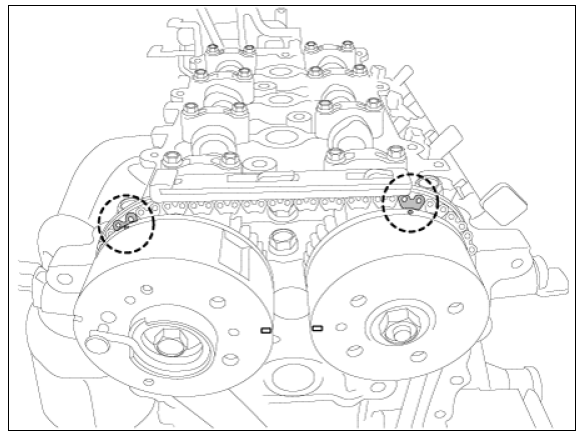
- Remove the timing.
(Refer to Timing System - "Timing Chain")
- Remove the intake CVVT assembly (A) and exhaust CVVT assembly (B).

- Remove the camshaft.
(1) Remove the camshaft front bearing cap and camshaft bearing cap in the sequence shown.

(2) Remove the camshafts (A).
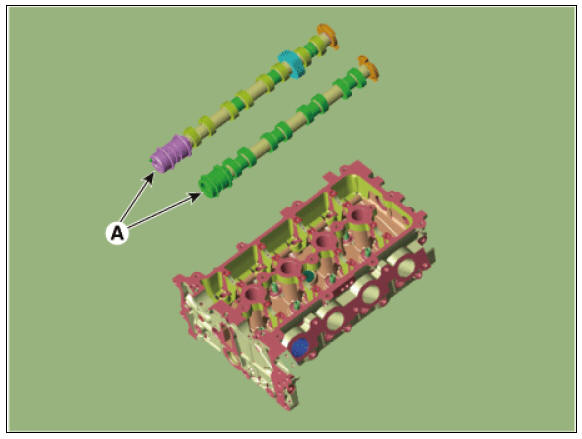
Inspection
Camshaft
- Inspect the cam lobes.
Using a micrometer, measure the cam lobe height.
If the cam lobe height is less than specification, replace the camshaft.
Cam height :
Intake: 36..42 mm (1.4339 in.)
Exhaust: 36.15 mm (1.4232 in.)
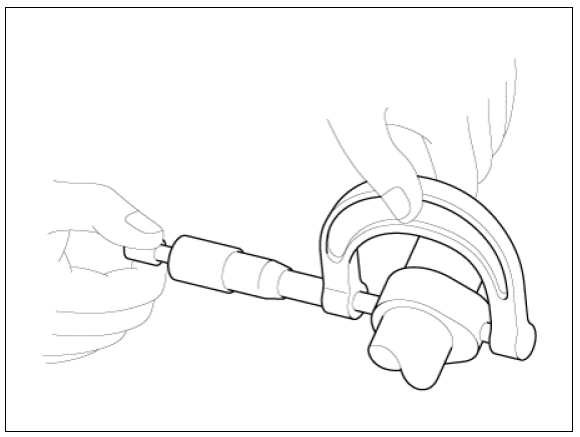
- Check the surface of the camshaft journal for wear.
If the journal is worn excessively, replace the camshaft.
- Inspect the camshaft journal clearance.
(1) Clean the bearing caps and camshaft journals.
(2) Place the camshafts on the cylinder head.
(3) Lay a strip of plastigage across each of the camshaft journal.

(4) Install the camshaft front bearing cap and camshaft bearing cap in the sequence shown.
Tightening torque
Step 1
M6 bolts :
5.9 N.m (0.6 kgf.m, 4.3 lb-ft)
M8 bolts :
9.8 N.m (1.0 kgf.m, 7.2 lb-ft)
Step
2M6 bolts :
11.8 - 13.7 N.m (1.2 - 1.4 kgf.m, 8.7 - 10.1 lb-ft)
M8 bolts :
18.6 - 22.6 N.m (1.9 - 2.3 kgf.m, 13.7 - 16.6 lb-ft)

Warning
Do not turn the camshaft.
(5) Remove the bearing caps.
(6) Measure the plastigage at its widest point.
If the oil clearance is greater than specification, replace the camshaft. If necessary, replace the bearing caps and cylinder head as a set.
Camshaft bearing oil clearance
Intake
No. 1 :
0.032 - 0.062 mm (0.0013 - 0.0024 in.)
No. 2,3,4,5 :
0.027 - 0.057 mm (0.0011 - 0.0022 in.)
Exhaust
No. 1 :
0.027 - 0.057 mm (0.0011 - 0.0022 in.)
No. 2,3,4,5 :
0.027 - 0.057 mm (0.0011 - 0.0022 in.)
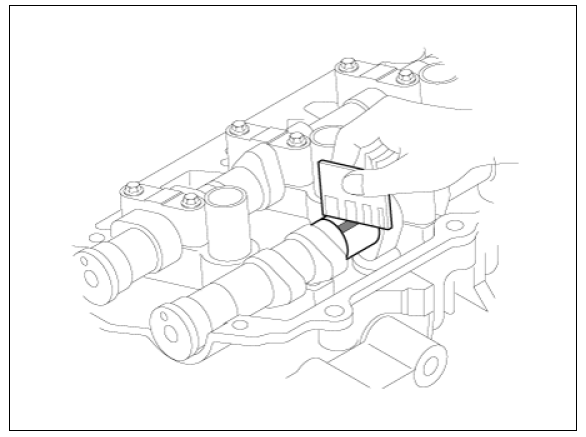
- Inspect the camshaft end play.
(1) Install the camshaft bearing caps.
(2) Using a dial indicator, measure the end play while moving the camshaft back and forth.
If the end play is greater than specification, replace the camshaft.
If necessary, replace the bearing caps and cylinder head as a set.
Camshaft end play :
Standard :
0.10 - 0.20mm (0.0039 - 0.0079 in.)

(3) Remove the camshafts.
Continuous variable valve timing (CVVT) Assembly
- Clamp the camshaft using a vise. Be careful not to damage the cam lobes and journals in the vise.
- Rotate the CVVT clockwise and counterclockwise to make sure that it is locked. It must not rotate.
- Intake CVVT : Seal one of the two advance holes in the camshaft journal
with tape.
Exhaust CVVT : Seal one of the two retard holes in the camshaft journal with tape.
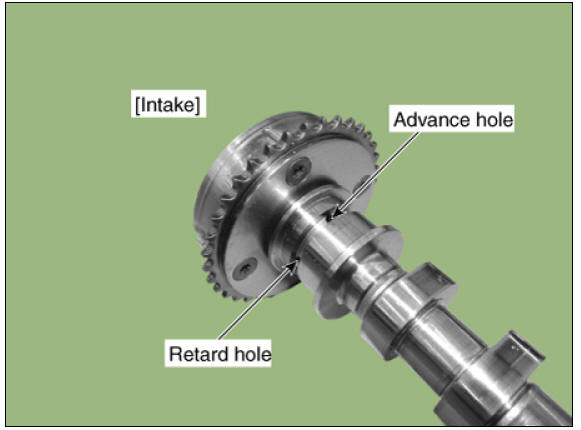
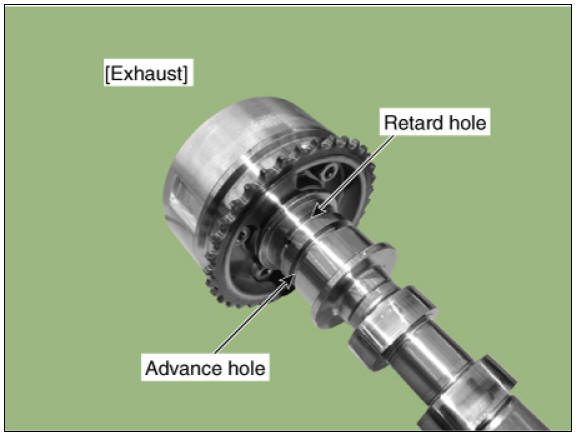
- Intake CVVT : Apply approx. 150 kPa (1.5 kgf/cm², 21 psi) of compressed
air into the unsealed advance hole to
release the lock.
Exhaust CVVT : Apply approx. 150 kPa (1.5 kgf/cm², 21 psi) of compressed air into the unsealed retard hole to release the lock.
Warning
Cover the oil paths with a piece of cloth when applying compressed air to prevent oil from spraying.
- Intake CVVT : With compressed air applied, rotate the CVVT in the
advance direction (counterclockwise)
within its phasing range and check that the CVVT turns smoothly.
Exhaust CVVT : With compressed air applied, rotate the CVVT in the retard direction (clockwise) and check that the CVVT turns smoothly.
CVVT phasing range :
Intake : .35º+-1º" (from the most retarded position to the most advanced position)
Exhaust : 20º+-1º" (from the most advanced position to the most retarded position)
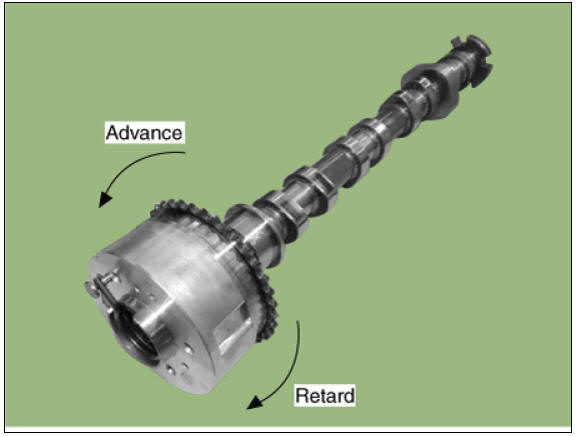
- Intake CVVT : Rotate the CVVT into the most retarded position (clockwise)
and then check that the CVVT is
locked.
Exhaust CVVT : Rotate the CVVT into the most advanced position (counterclockwise) and then check that the CVVT is locked.
Installation
- Install the camshaft
(1) Install the camshafts (A).

(2) Install the camshaft front bearing cap and camshaft bearing cap in the sequence shown.
Tightening torque
Step
1M6 bolts :
5.9 N.m (0.6 kgf.m, 4.3 lb-ft)
M8 bolts :
9.8 N.m (1.0 kgf.m, 7.2 lb-ft)
Step
2M6 bolts :
11.8 - 13.7 N.m (1.2 - 1.4 kgf.m, 8.7 - 10.1 lb-ft)
M8 bolts :
18.6 - 22.6 N.m (1.9 - 2.3 kgf.m, 13.7 - 16.6 lb-ft)
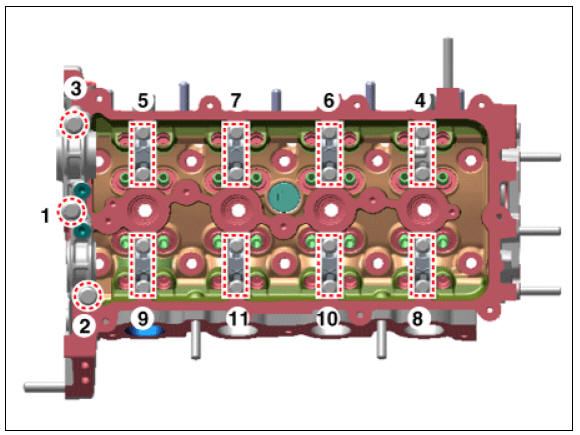
- Install the intake CVVT assembly (A) and exhaust CVVT assembly (B).
Tightening torque
Intake CVVT OCV bolt : (47.1 - 52.0 N.m (4.8 - 5.3 kgf.m, 34.7 - 38.3 lb-ft)) + (25 - 31º)
Exhaust CVVT bolt : 63.7 - 73.5 N.m (6.5 - 7.5 kgf.m, 47.0 - 54.2 lb-ft)

Warning
Do not use any dropped intake OCV & center bolt.
- Install in the reverse order of removal.
READ NEXT:
 Cylinder Head Repair procedures
Cylinder Head Repair procedures
Removal
Engine removal is not required for this procedure.
Warning
Be sure to read and follow the "General Safety Information and
Caution" before doing any work related
with the high voltage system. Failure to follow the safety instruction
 Cylinder Head
Cylinder Head
Inspect for flatness.
Using a precision straight edge and feeler gauge, measure the contacting
surface of the cylinder block and check
the manifolds for warpage.
If the flatness is greater than maximum, replace the cylinder head.
Fla
 HLA (Hydraulic Lash Adjuster)
HLA (Hydraulic Lash Adjuster)
With the HLA filled with engine oil, hold A and press B by hand.
If B moves, replace the HLA.
Reassembly
Warning
Thoroughly clean all parts to be assembled.
Before installing the parts, apply fresh engine oil to all
sliding
SEE MORE:
 Warning and indicator lights (Kia NIRO Hybrid)
Warning and indicator lights (Kia NIRO Hybrid)
Once you set the vehicle to the ON position, the symbols shown below will
light up. If these symbols remain on or malfunction, we
recommend having the vehicle inspected by an authorized Kia dealer/service
partner.
6 seconds
Th
 Rear wheel speed sensor
Rear wheel speed sensor
Rear wheel speed sensor
Rear Wheel Speed Sensor Components and components location
Removal
Remove the tire.
Disconnect the wheel speed sensor connector (A).
Loosen the bearing bolts (A) and then remove the hub bearing assem
Categories
- Home
- KIA Niro EV, Hybrid - Second generation - (SG2) (2021-2024) - Owner's manual
- Kia Niro - First generation - (DE) (2017-2022) - Service and Repair Manual
- Contact Us
